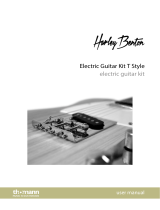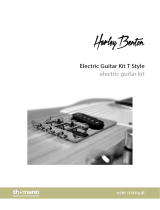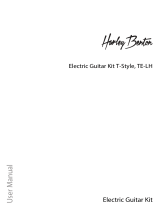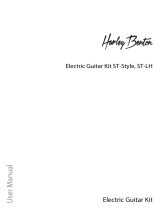
Solo TC Semi Hollow Style DIY Electric Guitar Kit
Copyright © 2017 Solo Music Gear. All rights reserved | v2.0
Safety : There will always be some woodworking and wiring that is required, whether it be sanding drilling cutting or
soldering. We expect that you will use common sense in making sure you are working safely; in a ventilated area, and
that you use the proper safety equipment including eye and ear protection. Whether you are doing the wood portion,
the electrical or the finishing, always enlist the help of people who are familiar with these skills in order to be safe. It's
always better to be safe than to be sorry!
Checklist : Now that you have received your new Solo DIY kit, we suggest that you read through all the instructions at
least once, so you are familiar with the process of assembling this instrument, and so that you can recognize the parts
described. Once you have read through, take a few minutes and check all the parts you have received. Because you are
familiar with the manual, you should be able to ensure you have everything required to complete this kit.
Before you begin to assemble any of the Solo kits, setting out a schedule of how you want to go about each instrument
is vital. Not all our kits follow the same path when it comes to finishing and assembly. First examine all the parts,
especially the bodies and necks. Are there imperfections? Are there dings and bumps you may have to sand out or fill?
Are the frets all seated properly and are there any sharp ends that extend past the edge of the neck that may need to be
filed smooth. Making sure all of the parts are as close to perfect as you can make them, will aid in a successful assembly.
If you have decided to apply a finish or paint to the body and neck of this instrument, you may want to go through the
whole assembly to make sure everything fits and all the holes are drilled before you embark on the finish (or paint).
Then, when your finish (or paint) has been applied and cured, you can assemble the instrument with the confidence that
comes from knowing everything will fit. Even the electronics can be pre-assembled to some degree (if they aren't
already) so that you can check wire length and pickup function. * in the case of bridges and tailpieces that have posts to
be pressure inserted into the body, you may not want to insert these until the finish (paint) has been applied, or you
may elect to insert them but cover the opening on the post with tape to protect the threads.
Also on the headstocks, many tuners have grommets that may need to be inserted....these too should wait until after
the finish (paint) is applied.
Disclaimer : We make sure the materials we include in our kits are safe to use and do not present any significant health
risk. However, we cannot take responsibility for any existing health conditions that may affect the person building these
kits, nor any responsibility arising from the assembly or work required in order to complete the kit. The kits can be
assembled without any finish or coating being applied, so we leave the entire subject of applying a finish or coating to
the bodies and necks up to the individual. There are ample websites and videos on the internet that can assist you in
putting a beautiful and lasting finish on this instrument, plus there are often classes available in night school and local
businesses that will be an aid to this process. We therefore do not take any responsibility in any issues that may arise
from or because of the finish application to this instrument. Likewise, we are not here to instruct in the art of soldering
or woodworking, so the responsibility lies with the person assembling this kit to obtain the proper instruction or help on
any part of the assembly process, and to complete the assembly process in a safe manor. If we could be there with you
to help you along, we would.....but we can't.










